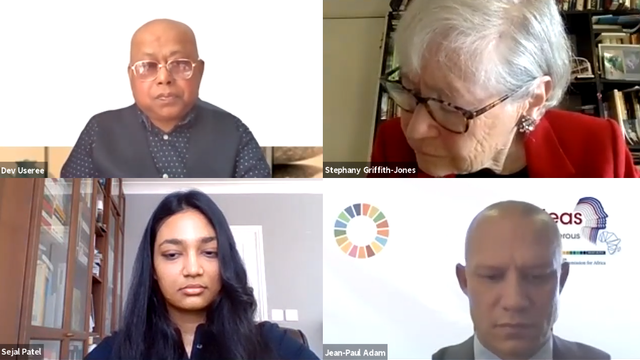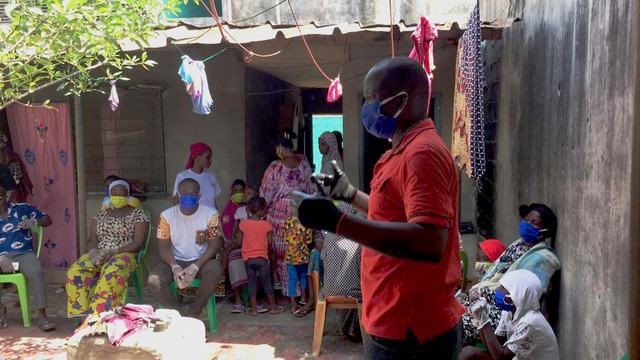Feeling the love
As Valentine's Day approaches, IIED is feeling the love in the responses to a publications survey – but there are also valuable lessons to be learned.


IIED received some warm responses to a survey on its publications carried out last year (Image: Nick Turner/IIED)
As Valentine's Day approaches, we all need a little bit of appreciation, so it was rewarding to sift through the comments to our publications survey and discover just how much our publications are valued.
But readers' responses also gave us some useful insights into how our publications are accessed and used, which should help us show our readers even more love in the future.
"Love you!" - a response to our publications survey
IIED has more than 5,000 publications available to download free of charge from our online library, and while we know how many times each publication is downloaded, we often don't know what happens next.
Our online survey, promoted via social media and our newsletter, was designed to answer that.
A barometer of audience behaviours
The results gave us some interesting insights. As well as having lots of useful specific information about how people use our publications, we've also gained a barometer of what works best when communicating with our audiences.
This will help us improve both the content and the way we disseminate our publications, as well as wider communications work to communicating with the right people, in the right way at the right time.
Some of the findings reinforced what we already knew. For example, respondents listed their main publication interest areas as climate change, natural resource management, food and agriculture and biodiversity – which matches up with high visitor numbers for the equivalent sections on the IIED website. Click on the mages below to expand them.
Some interesting observations
For me, some of the most useful feedback came from responses to the question asking what was the biggest influence on whether a publication gets read. Respondents told us that the title, opening summary and author were the biggest factors. From this, work has already started on how we can optimise titles and abstracts, in conjunction with existing work by our web development team to enhance our online library.
We are also running training sessions for our researchers on writing abstracts to help them make the most of their research.
The most common responses to the question about how people had heard about the institute were through an internet search, from our website, via our staff, Twitter and from email newsletters.
Help us to assess the impact of our publications by completing a short survey --> https://t.co/1YxgzeehnH #globaldev pic.twitter.com/YaHUfqWzin
— IIED (@IIED) February 1, 2015
This gives us further reason to strive to ensure that our publications can easily be found by users via search engines. It also confirms that Twitter and our monthly newsletter are valuable communication channels not just for sharing information, but for reaching out to new online audiences.
The PDF question
Inevitably, the survey results picked up on a subject often discussed among development sector communication specialists – the value and effectiveness of the PDF…
In general we found that PDFs are still popular with our audiences and that people prefer to access information for their work online, with the option to download a PDF and print it out.
While it is good to know that this format still resonates with our audiences, we still think there may be better formats out there – as suggested by the widely cited World Bank report, which states that nearly one-third of its PDF reports had never been downloaded and another 40 percent of its reports had been downloaded fewer than 100 times.
Clearly we need to continue to innovate and provide our audiences with research in formats that are accessible and easy to use.
We also asked: "What developments would you like to see in how we present our publications on the IIED website?" The suggestions included more online discussion and debate; publication reviews; practical tools, such as toolkits and webinars; the ability to save a library of previous downloads via a secure sign-in process; better search facilities and multimedia content such as videos and podcasts.
We are already exploring many of these and have, for example, already launched a new live search facility on the publications pages that auto-completes search terms as users type to enable them to find content more quickly.
We're also working on improving how our publications are accessed and read on mobiles and other devices. And we will continue trying to encourage discussion and debate whether through our blogs or discussion papers.
Tools for engagement
Another interesting observation not directly linked to publications readership, but evident from the results, was that email signatures and sparingly-used pop-ups can be effective ways to communicate with our audiences.
For example, 64 per cent of those who accessed the survey via the pop-up we installed for the survey signed up for our monthly newsletter, and three quarters of those who accessed the survey via an email signature went on to subscribe. These are useful findings and will support future work to drive up newsletter subscribers and other marketing campaigns.
What would we do differently?
An opportunity that we missed was not asking respondents for their contact details so that we can contact them for follow-up interviews. We would like to be able to gather case studies on impact and to build up a bank of stories of change that show donors (and others) the value of our publications.
We would also include questions around gender to ensure accessibility across all of our audience groups.
A pat on the back…
The survey results also allowed us to give ourselves a pat on the back for a job well done. Some of the comments we received are shown below, including my personal favourite… "love you!".

While it was nice to feel the love from our publications readers, there is still work to be done, both in developing our offer to our audiences as well as things we would do differently in future surveys.
Kate Wilson (kate.wilson@iied.org) is publications and marketing manager in IIED's Communications Group.





